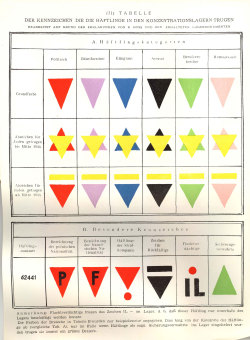Triangles on Prisoners’ Clothing

© Fritz Bauer Institute
In the concentration camps, every prisoner had to wear a triangle on his or her clothing, indicating the Haftgrund (reason for arrest). In the Buna/Monowitz concentration camp, the inmates had to sew a cloth strip about 4 cm wide and 12 cm long onto the left breast of the jacket and another onto the right pants leg, at pocket level, for this purpose. This badge displayed their prisoner number, which was tattooed on their left forearms upon arrival at the camp, and an inverted triangle, with its base up and one angle pointing down.
Almost 90 percent of the prisoners in the Buna/Monowitz concentration camp wore a red triangle identifying them as “political.” In the camps, the red triangle was used for Communists and Social Democrats at first, but soon it came to designate all opponents of the regime, generally including Jewish prisoners. In addition, the Jewish inmates also wore a superimposed yellow triangle with one angle pointing up to create a Star of David. Sometimes, however, they wore only a yellow stripe above the red triangle. All non-German inmates also had a capital letter inside the triangle to indicate their origin: “P” for Poles, “T” for Czechs, “U” for Hungarians, “F” for French, “B” for Belgians, “I” for Italians.
Around 8 percent of the prisoners in the Buna/Monowitz concentration wore a black triangle for the Haftgrund “asocial,” and about 5 percent a green triangle for “criminal.”[1] The green triangles had subcategories: If the angle pointed down, that meant “BV” (Berufsverbrecher, habitual criminal), that is, prisoners whose confinement in the concentration camp signified their conviction of a crime. If the angle pointed up, the inmate was in the “SV” category (Sicherheitsverwahrte, security detainees), who were still awaiting sentencing or were supposed to begin serving their time only after the war was over. It was the pool of wearers of black and green triangles from which the SS recruited most of the prisoner functionaries in the Buna/Monowitz concentration camp.
The combination of triangle and prisoner number—the immediate information about origin, length of presence in the camp, and Haftgrund—enabled the SS, as well as experienced prisoners, to quickly size up the situation of an inmate and thus frequently assess his chances of survival as well.
(MN; transl. KL)
















